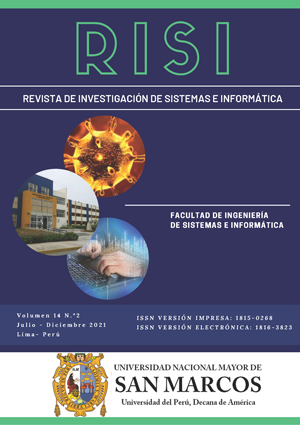Information and Communications Technology resources and the use of mobile learning in postgraduate students
DOI:
https://doi.org/10.15381/risi.v14i2.22336Keywords:
mobile learning, ict, internet connectivity, mobile device, digital tools, digital content, training in the use of ict resourcesAbstract
The trend on the implication of technology in university education is inevitable, in addition, the pandemic evidenced the importance of the capabilities of resources based on Information and Communications Technologies (ICT) that students must have to carry out activities related to his learning. The research constitutes an analysis of ICT resources and the use of Mobile Learning, made up of dimensions and indicators on which satisfaction levels were evaluated. The objective is to determine if the ICT resources and their dimensions: Internet Connectivity, Mobile Device, Digital Content, Digital Tools, and Training in the use of ICT resources are related, influence or impact the use of Mobile Learning. The approach is Qualitative. To collect the data, the survey technique and a 40-question questionnaire with a Likert scale from 1 to 5 were used. The population was made up of FISI Postgraduate students and the sample was made up of 70 students. The statistical results obtained were: for Spearman's Rho (0.837 and p-value < 0.05), Chi-square (171,287 and p-value < 0.05), Phi (1.564 and p-value < 0.05), Cramer's V (0.782, greater than 0.6) and the Contingency Coefficient (0.843, very close to 1); which showed the existence of a statistically significant, strong and positive relationship between ICT resources and the use of Mobile Learning with a high degree of dependence, where the use of Mobile Learning depends on ICT resources.
Downloads
Downloads
Published
Issue
Section
License
Copyright (c) 2022 Carlos Luis Euribe Solorzano, Hugo Froilán Vega Huerta

This work is licensed under a Creative Commons Attribution 4.0 International License.
AUTHORS RETAIN THEIR RIGHTS:
a. Authors retain their trade mark rights and patent, and also on any process or procedure described in the article.
b. Authors retain their right to share, copy, distribute, perform and publicly communicate their article (eg, to place their article in an institutional repository or publish it in a book), with an acknowledgment of its initial publication in the Revista de investigación de Sistemas e Informática.
c. Authors retain theirs right to make a subsequent publication of their work, to use the article or any part thereof (eg a compilation of his papers, lecture notes, thesis, or a book), always indicating its initial publication in the Revista de investigación de Sistemas e Informática (the originator of the work, journal, volume, number and date).


